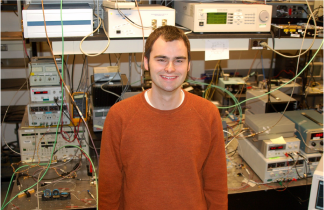(From Raydiance Inc)
As someone who has been trying to design novel ultrafast laser systems for the past eight years, my eyes were drawn to the title "Applications of Ultrafast Lasers" of Dr. Mike Mielke's talk from Raydiance, Inc. from the awesomely overwhelming list of invited speakers at CLEO 2012. Dr. Mielke's talk is one of a handful in CLEO's new Application and Technology conference which debuted last year in Baltimore in order to better bridge the gap between fundamental research and product commercialization.
To see what background information I could potentially find, I went to Raydiance's website to find a wealth of information on micromachining and a host of video shorts of ultrafast laser micromachining in action. They are so pleasing to watch, I couldn't help embedding many of them in this post.
Micromachinging with ultrafast lasers allows the removal of material without the introduction of heat (see the video above of laser micromachining on a match head without it igniting). Ultrafast lasers therefore give the advantages of laser machining- tailoring submicron features on the workpiece, without thermal collateral damage. For example, if you are going to have your dentist drill a tiny hole in one of your teeth (see the figure below) , you'd rather have her use the 350 fs laser shown in b) rather than 1.4 ns laser in a) in which the heat generated damages and fractures the tooth.

(Above: Drilling tooth enamel with a) 1.4 ns 30 J/cm2 laser pulses and b) with 350 fs 3 J/cm2 pulses. From B.C. Stuart et al LLNL.)
This is because drilling with the femtosecond pulses relies on an entirely different physical process for removal of material than nanosecond pulses. For long pulses (> 100 ps), photons are absorbed by the material and converted into heat. This eventually fractures, melts, or vaporizes material at (and nearby) the laser focus. On the other hand, if the pulse is fast enough (< 1 ps), the material is removed solely by photo-ionization. Rather than dumping energy into the material, electrons of target molecules are stripped off by the intense electric field of the pulse. No absorption takes place and therefore no heat is generated.
Because the mechanism for material removal using ultrafast pulses does not depend on the material properties as it does for thermal ablation, such as the melting point, conceivably any material can be machined using ultrafast pulses. This has allowed Raydiance to micromachine polymeric materials for manufacturing next-generation vascular stents and microfluidic devices (see the videos below).
(From Raydiance Inc)
Though micromachining using ultrafast lasers is not new, doing so in a robust workstation-platform is. Raydiance touts to have created the first "industrial grade" femtosecond laser platform. They have an impressive record and a current partnership with ROFIN GmbH for the development of industrial-grade femtosecond laser micromachining workstations. In the literature on their website they state, "A laser is not a solution. It might be the engine of a solution, however, 21st century manufacturing floors demand more: software integration, beam delivery, motion control, and visioning systems." As an "engine builder" myself it is helpful to know just what kind of engine is the most useful to workstation integration. Sometimes "engine builders" get caught up in making Formula One cars when what is most helpful is a reliable Hyundai sedan. Although not any pulse width, energy, and rep will do for athermal ablation, neither will a workstation without robust, continuous (thousands of hours 24/7), turn-key operation.
(From Raydiance Inc)
To that end, Raydiance's core platform, Smart Light, can simply be adapted (mainly turning down the power) for non-machining applications in defense and security such as remote sensing of hazardous chemicals and LADAR. Dr. Mielke's invited talk will likely emphasize Raydiance's pursuits in these areas since his talk is in the Government and Security subcategory. I will be interested to see what wavelength tuning options, wavelength conversion, or different center wavelengths Raydiance may be investigating for threat detection since Smart Light currently resides in the telecom C-band near 1550 nm and many absorption lines for molecules of interest live in the mid-IR. Until then, I hope you will enjoy, like me, these videos of lasers "vaporizing" material and leaving beautiful designs for very practical applications.












